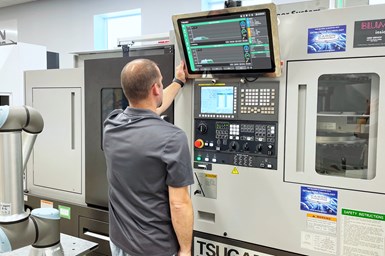See What Lights-Out Machining Looks Like
Caron Engineering demonstrates machining technology that, when combined, can offer peace of mind when shutting off the lights and heading home for the evening.

Lights-out machining doesn’t have to be scary when you develop a reliable process using advanced technology. Photo Credit: Caron Engineering
Establishing an unattended machining process that you’re confident will run reliably throughout the evening when nobody’s around can be a challenge. In booth 135736 in the well-lit East building, Caron Engineering demonstrates technology that, when combined, can offer peace of mind when shutting off the lights and heading home for the evening.
There you can see a live demonstration of a Tsugami TMA8 turn-mill from Tsugami America (formerly Tsugami-REM Sales) with a cobot from Universal Robots prepped for lights-out production. This includes Caron’s ToolConnect tool data management system which reads and processes tool-presetter-written RFID tags and 2D-printed barcode tags to automatically update tool information directly to the machine’s CNC; TMAC adaptive tool monitoring system designed to optimize cutting by measuring tool wear and detecting breakage in real time; DTect-IT Software that extracts data from a Blum-Novotest scanning probe that analyzes the surface of the part and determines any dimensional anomalies to ensure consistent part quality; a Blum-Novotest LC50 Digilog laser that automatically measures rotating tools; MiConnect Technology flowchart-style programming that controls the interaction between the turn-mill’s CNC; and AutoComp Software which automatically processes the measurement data from a Sylvac Scan25 vision gage to calculate and compensate offsets in the machine’s control.
The moral of this story: If you want to make bank machining, don’t be afraid of the dark.
RELATED CONTENT
-
What Is The Best Bar Feed System For Production Turning?
Selecting the right bar feeder can be one of the most important decisions a shop can make. Bar feed systems help improve productivity, throughput and quality, but in order to achieve the most benefit from them it is essential that a bar feed system be matched to the particular needs of the turning operation.
-
Job Shop Automation: Fast, Simple and Agile
When done right, automation can provide important benefits. Here’s a look at automation options to suit the varying needs of typical job shops.
-
Choosing an Automatic Bar Feeder
The bar feeder is the most common form of automation for turning operations. Selecting the right one requires consideration of the applications for which it will be used.



